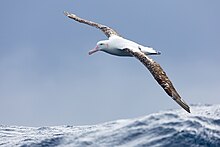
Procellariiformes is an order of seabirds that comprises four families: the albatrosses, the petrels and shearwaters, and two families of storm petrels. Formerly called Tubinares and still called tubenoses in English, procellariiforms are often referred to collectively as the petrels, a term that has been applied to all members of the order, or more commonly all the families except the albatrosses. They are almost exclusively pelagic, and have a cosmopolitan distribution across the world's oceans, with the highest diversity being around New Zealand.

The snowy albatross, also known as the white-winged albatross, wandering albatross, or goonie, is a large seabird from the family Diomedeidae; they have a circumpolar range in the Southern Ocean. It is the most recently described species of albatross and was long considered to be the same species as the Tristan albatross and the Antipodean albatross. Together with the Amsterdam albatross, it forms the wandering albatross species complex. When the complex was split into four species, the English name of the nominate form was changed from wandering albatross to snowy albatross.

The black-footed albatross is a large seabird of the albatross family Diomedeidae from the North Pacific. All but 2.5% of the population is found among the Northwestern Hawaiian Islands. It is one of three species of albatross that range in the northern hemisphere, nesting on isolated tropical islands. Unlike many albatrosses, it is dark plumaged.

The Laysan albatross is a large seabird that ranges across the North Pacific. The Northwestern Hawaiian Islands are home to 99.7% of the population. This small gull-like albatross is the second-most common seabird in the Hawaiian Islands, with an estimated population of 1.18 million birds, and is currently expanding its range to new islands. The Laysan albatross was first described as Diomedea immutabilis by Lionel Walter Rothschild, in 1893, on the basis of a specimen from Laysan Island.
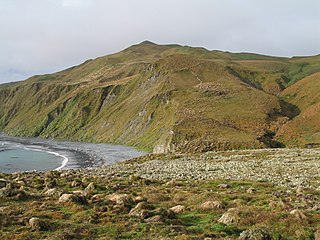
The Antipodes Subantarctic Islands tundra ecoregion, within the tundra biome, includes five remote island groups in the Pacific Ocean south of New Zealand: the Bounty Islands, Auckland Islands, Antipodes Islands and Campbell Island groups of New Zealand, and Macquarie Island of Australia.

The Amsterdam albatross or Amsterdam Island albatross,, is a large albatross which breeds only on Amsterdam Island in the southern Indian Ocean. It was only described in 1983, and was thought by some researchers to be a subspecies of the wandering albatross, D. exulans. BirdLife International and the IOC recognize it as a species, James Clements does not, and the SACC has a proposal on the table to split the species. More recently, mitochondrial DNA comparisons between the Amsterdam albatross, the wandering albatross Diomedea exulans, the Antipodean albatross D. antipodensis and the Tristan albatross D. dabbenena, provide clear genetic evidence that the Amsterdam albatross is a separate species.

The grey-headed albatross also known as the gray-headed mollymawk, is a large seabird from the albatross family. It has a circumpolar distribution, nesting on isolated islands in the Southern Ocean and feeding at high latitudes, further south than any of the other mollymawks. Its name derives from its ashy-gray head, throat and upper neck.

The great albatrosses are seabirds in the genus Diomedea in the albatross family. The genus Diomedea formerly included all albatrosses except the sooty albatrosses, but in 1996 the genus was split, with the mollymawks and the North Pacific albatrosses both being elevated to separate genera.
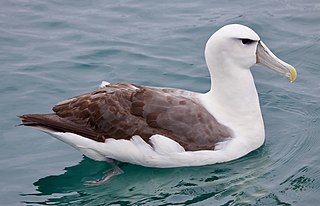
The white-capped albatross is a mollymawk that breeds on the islands off of New Zealand. Not all experts agree that this form should be recognized as a separate species from the shy albatross, Thalassarche cauta. It is a medium-sized black, slate gray, and white albatross and is the largest of the mollymawks.
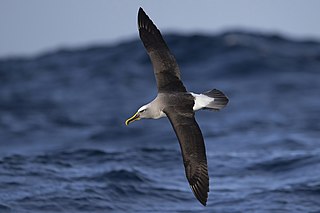
Buller's albatross or Buller's mollymawk, is a small mollymawk in the albatross family.
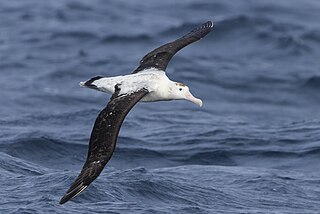
The Antipodean albatross is a large seabird in the albatross family. Antipodean albatrosses are smaller than snowy albatrosses, and breed in predominantly brown plumage, but are otherwise difficult to distinguish from young snowy albatrosses.

The northern royal albatross or toroa, is a large seabird in the albatross family. It was split from the closely related southern royal albatross as recently as 1998, though not all scientists support that conclusion and some consider both of them to be subspecies of the royal albatross.

The southern royal albatross or toroa, is a large seabird from the albatross family. At an average wingspan of above 3 m (9.8 ft), it is one of the two largest species of albatross, together with the wandering albatross. Recent studies indicate that the southern royal albatross may, on average, be somewhat larger than the wandering albatross in mass and have a similar wingspan, although other sources indicate roughly similar size for the two species and the wandering species may have a larger average wingspan in some colonies.

The Tristan albatross is a large seabird from the albatross family. One of the great albatrosses of the genus Diomedea, it was only widely recognised as a full species in 1998.

Albatrosses, of the biological family Diomedeidae, are large seabirds related to the procellariids, storm petrels, and diving petrels in the order Procellariiformes. They range widely in the Southern Ocean and the North Pacific. They are absent from the North Atlantic, although fossil remains of short-tailed albatross show they once lived there up to the Pleistocene, and occasional vagrants are found. Great albatrosses are among the largest of flying birds, with wingspans reaching up to 2.5–3.5 metres (8.2–11.5 ft) and bodies over 1 metre (3.3 ft) in length. The albatrosses are usually regarded as falling into four genera, but disagreement exists over the number of species.

The New Zealand fairy tern or tara-iti is a subspecies of the fairy tern endemic to New Zealand. It is New Zealand's rarest native breeding bird, with about 40 individuals left in the wild. It nests at four coastal locations between Whangārei and Auckland in the North Island. It is threatened by introduced predators, extreme storms and tides, beach activity, and waterfront development.
John Douglas Gibson was an Australian amateur ornithologist who became an internationally respected expert on the Diomedeidae or albatross family.

The term seabird is used for many families of birds in several orders that spend the majority of their lives at sea. Seabirds make up some, if not all, of the families in the following orders: Procellariiformes, Sphenisciformes, Pelecaniformes, and Charadriiformes. Many seabirds remain at sea for several consecutive years at a time, without ever seeing land. Breeding is the central purpose for seabirds to visit land. The breeding period is usually extremely protracted in many seabirds and may last over a year in some of the larger albatrosses; this is in stark contrast with passerine birds. Seabirds nest in single or mixed-species colonies of varying densities, mainly on offshore islands devoid of terrestrial predators. However, seabirds exhibit many unusual breeding behaviors during all stages of the reproductive cycle that are not extensively reported outside of the primary scientific literature.
The Gibson Plumage Index (GPI), sometimes known as the Gibson Code, is a system for describing the plumage of great albatrosses. It is named after, and originally devised in the late 1950s by, John Douglas Gibson and other members of the New South Wales Albatross Study Group. Gibson was an Australian amateur ornithologist who carried out fieldwork on albatrosses along the coast of New South Wales for thirty years. The index assigns separate numerical values to the degrees of colouration on four parts of the body - the back, head, inner wing and tail - of albatrosses to indicate variations in age and between different breeding populations. For instance, a bird with a completely brown back would receive a score of 1 for the back, while a bird with an all-white back would be scored as a 6. The index was later expanded by Pierre Jouventin and colleagues to cover the more complex patterning of the Amsterdam albatross, adding belly and tibial feather colouration. This system for categorising the wide and complex variation in appearance of great albatrosses has been instrumental in the discovery of several genetically isolated populations and consequent description of new taxa, and has made field identification easier.

The New South Wales Albatross Study Group (NSWASG) was an amateur ornithological fieldwork group that banded albatrosses and other seabirds off the coast of eastern New South Wales, Australia. Primarily targeting winter feeding aggregations of wandering albatrosses near Sydney, it developed its own catching methods and initiated what has become the longest-running continuous albatross research study in the world.
